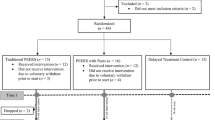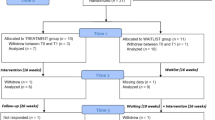Abstract
This study examines the impact of a video-based intervention to increase children’s knowledge and positive attitudes toward a peer with Tourette Syndrome (TS). TS, a neurological disorder characterized by verbal and motor tics, is a confusing and potentially stigmatizing disorder. Although symptoms wax and wane over the life span, TS typically begins in childhood and peaks at puberty. The available literature suggests that individuals with TS are at risk for social rejection; because TS is primarily a childhood disorder, many of the social adjustment problems experienced by individuals with the disorder have their roots in negative childhood experiences in the classroom. An intervention was developed and evaluated using a pretest, posttest control group study. Children exposed to the intervention video showed greater changes in knowledge, positive attitudes, and behavioral intentions than a control group. Such interventions may have potential to improve social outcomes for children with differences.

Similar content being viewed by others
References
Ajzen, I. (1980). Understanding the attitudes and predicting social behavior. Englewood Cliffs, New Jersey: Prentice-Hall.
Ajzen, I., & Fishbein, M. (1977). Attitude-behavior relations: A theoretical analysis and review of empirical research. Psychological Bulletin, 84, 888–918.
Bagwell, C. L., Newcomb, A. F., & Bukowski, W. M. (1998). Preadolescent friendship and peer rejection as predictors of adult adjustment. Child Development, 69(1), 140–153.
Bauer, A. M., & Shea, T. A. (1984). Tourette syndrome: A review and educational implications. Journal of Autism and Developmental Disorders, 14, 69–80.
Bauman, L. J., Drotar, D., Leventhal, J. M., Perrin, E. C., & Pless, I. B. (1997). Review of psychosocial interventions for children with chronic health conditions. Pediatrics, 100, 24–251.
Bawden, H. N., Stokes, A., Camfield, C. S., Camfield, P. R., & Salisbury, S. (1998). Peer relationship problems in children with Tourette’s disorder or Diabetes Mellitus. Journal of Child Psychology and Psychiatry, 39(5), 663–668.
Boudjouk, P. J., Woods, D. W., Miltenberger, R. G., & Long, E. S. (2000). Negative peer evaluation in adolescents: Effects of tic disorders and Trichotillomania. Child & Family Behavior Therapy, 22(1), 17–28.
Budman, C. L., & Feirman, L. (2001). The relationship of Tourette’s Syndrome with its psychiatric comorbidities: Is there an overlap? Psychiatric Annals, 31(9), 541–548.
Bussing, R., Zima, B. T., & Perwien, A. R. (2000). Self-esteem in special education children with ADHD: Relationship to disorder characteristics and medication use. Journal of the American Academy of Child and Adolescent Psychiatry, 39(10), 1260–1269.
Carter, A. S., O’Donnell, D. A., Schultz, R. T., Scahill, L., Leckman, J. F., & Pauls, D. L. (2000). Social and emotional adjustment in children affected with Gilles de la Tourette’s Syndrome: Associations with ADHD and family functioning. Journal of Child Psychology, Psychiatry, and Allied Disciplines, 41(2), 215–223.
Champion, L. M., Fulton, W. A., & Shady, G. A. (1988). Tourette Syndrome and social functioning in a Canadian population. Neuroscience & Biobehavioral Reviews, 12, 255–257.
Children’s Television Workshop. (1992). Brainstorm: The truth about your brain on drugs (video). Pleasantville, NY: Sunburst Communications.
Cohen, J. D., & Leckman, J. F. (1994). Developmental psychopathology and neurobiology of Tourette’s Syndrome. Journal of the American Academy of Child & Adolescent Psychiatry, 33(1), 2–15.
Coie, J. D., Dodge, K. A., & Kupersmidt, J. B. (1990). Peer group behavior and social status. In S. R. Asher & J. D. Coie (Eds.), Peer rejection in childhood (pp. 17–59). Cambridge, England: Cambridge University Press.
Coie, J., Terry, R., Lenox, K., & Lochman, J. (1995). Childhood peer rejection and aggression as predictors of stable patterns of adolescent disorder. Development and Psychopathology, 7(4), 697–713.
Crick, N. R. (1993). Children’s perceptions of their peer experiences: Attributions, loneliness, social anxiety, and social avoidance. Developmental Psychology, 29(2), 244–254.
Crick, N. R., & Dodge, K. A. (1994). A review and reformulation of social information-processing mechanisms in children’s social adjustment. Psychological Bulletin, 115(1), 74–101.
Curtis, D., Robertson, M. M., & Gurling, H. M. D. (1992). Autosomal dominant gene transmission in large kindred with Gilles de la Tourette syndrome. British Journal of Psychiatry, 160, 845–849.
Danya International. (1999). You’ve got a friend. Silver Spring, MD. Available at www.danya.com.
Demellweek, C., Humphris, G. M., Hare, M., & Brown, J. (1997). Children’s perception of and attitude toward unfamiliar peers with facial port-wine stains. Journal of Pediatric Psychology, 22(4), 471–485.
Favazza, P. C., & Odom, S. L. (1997). Promoting positive attitudes of kindergarten-age children toward people with disabilities. Exceptional Children, 63, 405–418.
Favazza, P. C., Phillipsen, L., & Kumar, P. (2000). Measuring and promoting acceptance of young children with disabilities. Exceptional Children, 66, 491–508.
Fishbein, M., & Ajzen, I. (1975). Belief, attitude, intention, and behavior: An introduction to theory and research. Reading, MA: Addison-Wesley.
Foley, J. M. (1979). Effect of labeling and teacher behavior on children’s attitudes. American Journal of Mental Deficiency, 80, 72–80.
Frederickson, N., & Turner, J. (2003). Utilizing the classroom peer group to address children’s social needs: An evaluation of the Circle of Friends Intervention Approach. Journal of Special Education, 36(4), 234–245.
Friedrich, S., Morgan, S. B., & Devine, C. (1996). Children’s attitudes and behavioral intentions toward a peer with Tourette Syndrome. Journal of Pediatric Psychology, 21(3), 307–319.
Gentschel, D. A., & McLaughlin, T. F. (2000). Attention deficit hyperactivity disorder as a social disability: Characteristics and suggested methods of treatment. Journal of Developmental and Physical Disabilities, 12(4), 333–347.
Goodell, A. (1984). Peer education in schools for children with cancer. Issues in Comprehensive Pediatric Nursing, 7(2–3), 101–106.
Greener, S., & Crick, N. R. (1999). Normative beliefs about prosocial behavior in middle childhood: What does it mean to be nice? Social Development, 8(3), 349–364.
Halloran, J. D. (1967). Attitude formation and change. Great Britain: Leicester University Press.
Hammond, M. (2000). The influence of video and peer tutoring on attitudes of high school students towards peers with disabilities. Dissertation Abstracts International: Section B: The Sciences & Engineering, 60(11-B), 5834.
Harter, S. (1982). The perceived competence scale for children. Child Development, 53(1), 87–97.
Hawker, D. S., & Boulton, M. J. (2000). Twenty years’ research on peer victimization and psychosocial maladjustment: A meta-analytic review of cross-sectional studies. Journal of Child Psychology and Psychiatry, 41(4), 441–455.
Hornsey, H., Banerjee, S., Zeitlin, H., & Robertson, M. (2001). The prevalence of Tourette Syndrome in 13–14 year olds in mainstream schools. Journal of Child Psychology and Psychiatry, 42(8), 1035–1039.
Ibrahim, F. A., & Herr, E. L. (1982). Modification of attitudes toward disability: Differential effect of two educational modes. Rehabilitation Counseling Bulletin, 26(1), 29–36.
Jagger, J., Prusoff, B. A., Cohen, D. J., Kidd, K. K., & Carbonari, C. M. (1982). The epidemiology of Tourette’s Syndrome: A pilot study. Schizophrenia Bulletin, 8(2), 267–278.
Kadesjo, B., & Gillberg, C. (2000). Tourette’s disorder: Epidemiology and comorbidity in primary school children. Journal of the American Academy of Child and Adolescent Psychiatry, 39(5), 548–555.
Katz, E. R., Varni, J. W., Rubenstein, C. L., Blew, A., & Hubert, N. (1992). Teacher, parent, and child evaluative ratings of school reintegration interventions for children with newly diagnosed cancer. Children’s Health Care, 21(2), 69–75.
Kottke, J. L., Mellor, S., & Schmidt, A. C. (1987). Effects of information on attitudes toward an interpersonal acceptance of persons who are deaf. Rehabilitation Psychology, 32(4), 239–244.
Laird, R. D., Jordan, K. Y., Dodge, K. A., Pettit, G. S., & Bates, J. E. (2001). Peer rejection in childhood, involvement with antisocial peers in early adolescence, and the development of externalizing behavior problems. Development and Psychopathology, 13(2), 337–354.
Leckman, J., Heping Z., Vitale, A., Lahnin, F., Lynch, K., Bondi, C., et al. (1998). Course of tic severity in Tourette Syndrome: The first two decades. Pediatrics, 102(2), 14–19
Lopez, C., & DuBois, D. (2005). Peer victimization and rejection: Investigation of an integrative model of effects on emotional, behavioral, and academic adjustment in early adolescence. Journal of Clinical Child and Adolescent Psychology, 34(1), 25–36.
Marcus, D., & Kurlan, R. (2001). Tics and its disorders. Neurologic Clinics, 19(3), 735–758.
Matthews, W. S., & Barabas, G. (1985). Recent advances in developmental pediatrics related to achievement and social behavior. School Psychology Review, 14, 182–187.
Mathews, R. M., White, G. W., & Mrdjenovich-Hanks, P. (1990). Using a slide presentation to change attitudes toward people with disabilities. Rehabilitation Counseling Bulletin, 33(4), 301–306.
Miller-Johnson, S., Coie, J. D., Maumary-Gremaud, A., & Bierman, K. (2002). Peer rejection and aggression and early starter models of conduct disorder. Journal of Abnormal Child Psychology, 30(3), 217–230.
Nomura, Y., Kita, M., & Segawa, M. (1992). Social adaptation of Tourette syndrome families in Japan. Advances in Neurology, 58, 323–332.
Odom, S. L., McConnell, S. R., McEvoy, M. A., Peterson, C., Ostrosky, M., Chandler, L. K., et al. (1999). Relative effects of interventions supporting the social competence of young children with disabilities. Topics in Early Childhood Special Education, 19, 75–91.
Packer, L. (1997). Social and educational resources for patients with Tourette Syndrome. Neurologic Clinics of North America, 15(2), 457–473.
Packer, L. (2005). Tic-related school problems: Impact on functioning, accommodations, and interventions. Behavior Modification, 29(6), 876–899.
Peavey, K. O., & Leff, D. (2002). Social acceptance of adolescent mainstreamed students with visual impairments. Journal of Visual Impairment and Blindness, 96(11), 808–811.
Prestia, K. (2003). Tourette’s Syndrome: Characteristics and interventions. Intervention in School and Clinic, 39(2), 67–71.
Roff, J. D. (1990). Childhood peer rejection as a predictor of young adults’ mental health. Psycholgical Reports, 67(3), 1263–1266.
Rosenbaum, P. L., Armstrong, R. W., & King, S. M. (1986). Improving attitudes toward the disabled: A randomized controlled trial of direct contact versus Kids-on-the-Block. Developmental Behavioral Pediatrics, 7(5), 302–307.
Skinner, R. A., & Piek, J. P. (2001). Psychosocial implications of poor motor coordination in children and adolescents. Human Movement Science, 20(1–2), 73–94.
Stokes, A., Bawden, H., Camfield, P., Backman, J., & Dooley, J. (1991). Peer problems in Tourette’s disorder. Pediatrics, 87(6), 936–942.
Varni, J. W., Katz, E. R., Colegrove, R., & Dolgin, M. (1993). The impact of social skills training on the adjustment of children with newly diagnosed cancer. Journal of Pediatric Psychology, 18(6), 751–768.
Voeltz, L. (1982). Effects of structured interactions with severely handicapped peers on children’s attitudes. American Journal of Mental Deficiency, 86, 380–390. EJ 259 650.
Wallander, J. L., & Varni, J. W. (1989). Social support and adjustment in chronically ill and handicapped children. American Journal of Community Psychology, 17(2), 185–201.
Westervelt, V. D., Brantley, J., & Ware, W. (1983). Changing children’s attitudes toward physically handicapped peers: Effects of a film and teacher-led discussion. Journal of Pediatric Psychology, 8(4), 327–343.
Wisely, D. W., & Morgan, S. B. (1981). Children’s ratings of peers presented as mentally retarded and physically handicapped. American Journal of Mental Deficiency, 86, 281–286.
Woods, D. W. (2002). The effect of video-based peer education on the social acceptability of adults with Tourette Syndrome. Journal of Developmental and Physical Disabilities, 14, 51–62.
Woods, D. W., Fuqua, R. W., & Outman, R. C. (1999). Evaluating the social acceptability of persons with habit disorders: The effects of topography, frequency, and gender manipulation. Journal of Psychopathology and Behavioral Assessment, 21(1), 1–18.
Woods, D. W., & Marks, B. A. (2005). Controlled evaluation of an educational intervention used to modify peer attitudes and behavior toward persons with Tourette’s Syndrome. Behavior Modification, 29(6), 900–912.
Acknowledgements
This research was made possible through NIMH Grant No. R43 MH58518-01A1. Many thanks to the Tourette Syndrome of Greater Washington for all their help.
Author information
Authors and Affiliations
Corresponding author
Rights and permissions
About this article
Cite this article
Holtz, K.D., Tessman, G.K. Evaluation of a Peer-focused Intervention to Increase Knowledge and Foster Positive Attitudes Toward Children with Tourette Syndrome. J Dev Phys Disabil 19, 531–542 (2007). https://doi.org/10.1007/s10882-007-9042-z
Received:
Accepted:
Published:
Issue Date:
DOI: https://doi.org/10.1007/s10882-007-9042-z




